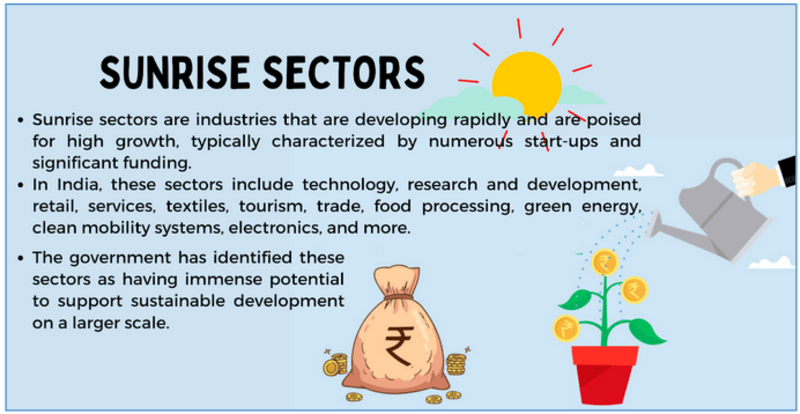R&D spend — golden intervention or smoke and mirrors
Relevance: GS III (Science and Technology
- Prelims: Government Initiatives in Innovation and Technology; Sunrise Sectors;
- Mains: Government Initiatives in Innovation and Technology; Sunrise Sectors;
Why in the News?
The government needs to spell out how it plans to select the beneficiaries (from interim budget ‘24) of the corpus of ₹1 lakh crore for private sector research and innovation.
About:
- The Indian government has announced a corpus of ₹1 lakh crore for private sector research and innovation in sunrise domains. The private sector's contribution to India's overall research and development expenditure as a fraction of GDP has been low.
- The purpose of innovation has expanded from economic growth to include environmental justice and sustainability.
- The government needs to define what the corpus is expected to achieve, whether it will have domain-wise allocations and targets, and how the government intends to select beneficiaries and whether the corpus will be replenished.
- The corpus will provide long-term financing or refinancing with long tenures and low or nil interest rates to encourage the private sector to scale up research and innovation significantly in sunrise domains.
|
The private sector’s contribution to India’s R&D:
|
Why does private sector contribution need to lead its public sector counterpart?
- The split of the GERD contributions from government, private entities, and higher education in economically developed countries is some sort of benchmark.
- The question of the virtue of hiking the public sector’s R&D contribution is important because it is rooted in India’s development model and the purpose of technological innovation in it.
- For example, the post-war U.S. famously adopted Vannevar Bush’s “free play of free intellects” model in which fundamental research was expected to spur technological growth.
- Japan, South Korea, and some other economies tread a “techno-nationalist” path from the late 20th century, focused “on building interconnectedness among universities, research institutes, companies and governments”.
Innovation’s purpose has expanded
- The purpose of innovation has broadened to encompass environmental justice and sustainability, moving beyond mere economic growth.
- With increasing income inequality, diminishing environmental protections, and growing privatization of public goods, there is no inherent virtue in private-sector dominance in research and development (R&D).
- The state is better equipped to manage the long-term and risk-laden nature of innovation.
- Therefore, there is a need for increased public sector R&D spending, particularly at the state level, to support locally relevant research and facilitate the transition of research from the lab to practical applications.
- The expansion of innovation's purpose necessitates a reevaluation of the balance between private and public sector contributions to R&D.
Sunrise Sector: A catch

- The availability of a corpus of ₹1 lakh crore and long-term low-interest loans is a lip-smacking prospect. Private sector contribution does need to increase considering the focus and incentives India has conferred on technological prowess in the last decade
- Both private sector investment in R&D and its sluggish increase span through multiple domains will all be making plans for this money.
- Government has maintained a focus on “sunrise sectors”. By virtue of being ‘sunrise’, almost all of them are resource-intensive, and we must also ask how much it will cost to keep them climate-friendly.
Way Forward:
- Expenditure also needs to increase: As such, ₹1 lakh crore — or a little over $2 billion — is likely to be a pittance if innovation in any sunrise domain is to be meaningful beyond surpassing some fraction of the national GERD.
- For example, according to the Indian Bio Economy Report 2023, prepared by the Biotechnology Industry Research Assistance Council, helping startups transition from bio-economy research to bio-manufacturing would require an infusion of $2 billion.
- Need to be Target specific: With so many demands on the corpus, the government needs to define what it is expected to achieve, whether it will have domain-wise allocations and targets, and time frame; and how the government intends to select beneficiaries and whether the corpus will be replenished.
Conclusion: It would be unfair to dismiss it at unspecific targets, and the answers will mark the line between golden intervention and smoke and mirrors. Expenditure also needs to increase to the extent that, with suitable policies, it relieves the persistent bottleneck of research graduating from the lab bench to the factory floor. Innovation is of little value without this flow, and will be restricted to low-quality advancements.
Mains PYQs
- What are the salient features of ‘inclusive growth’? Has India been experiencing such a growth process? Analyze and suggest measures for inclusive growth. (2017)
- “Industrial growth rate has lagged behind in the overall growth of Gross-Domestic-Product (GDP) in the post-reform period” Give reasons. How far are the recent changes in Industrial Policy capable of increasing the industrial growth rate? (2017)
- There is a growing divergence in the relationship between poverty and hunger in India. The shrinking of social expenditure by the government is forcing the poor to spend more on non-food essential items squeezing their food budget. Elucidate. (2019)
- Define potential GDP and explain its determinants. What are the factors that have been inhibiting India from realizing its potential GDP? (2020)


